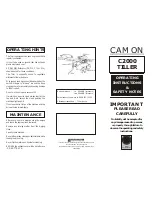
15
When the cooler pump control is set to “1” and the cooler
pump interlock is set to “1” an alarm 53 will be generated if
flow is not proven within one minute after the cooler pump re-
lay is energized. An alarm 55 will be generated if the interlock
contacts remain closed when the cooler pump relay is off. In ei-
ther cooler pump control configuration, alarm 54 will be gener-
ated whenever the cooler pump interlock is open for at least
5 seconds during operation.
CONDENSER PUMP CONTROL (
) — Factory de-
faults for both condenser pump control and condenser flow
switch are set to “Not Controlled” and “Disabled,” respec-
tively. The condenser pump can be controlled in one of two
ways: In the first method, the pump can be controlled like the
cooler pump — it is turned on whenever the machine is in the
on state and turned off otherwise (set to “1” using the Service
function). The second method of control is to turn the pump on
when the first compressor is started and off when the last com-
pressor is turned off (set to “2” using the Service function).
With the flow switched enabled, the control checks the status
of the input one minute after starting the pump. An alarm 49 is
generated if the flow switch input is not closed.
Cooler Heater Control —
Accessory cooler heaters
can be ordered for the 30GX chillers. If installed and enabled,
these heaters are turned on only when the machine is in the off
state and the chiller is in a saturated suction temperature freeze
condition.
Oil Heater Control —
Standard feature that controls oil
temperature based on Saturated Condensing Temperature
(SCT). Heaters turn on at <105 F (40.6 C) SCT, and turn off at
>110 F (43.3 C) SCT.
Keypad and Display Module (Also Called
HSIO-II) —
This module allows the operator to communi-
cate with the processor. It is used to enter configurations and
set points and to read data, perform tests, and set schedules.
The device consists of a keypad with 7 function keys, 5 opera-
tive keys, 12 numeric keys (0 to 9, •, and -), and a 2-line,
24-character alphanumeric liquid crystal display. See Fig. 7.
ACCESSING FUNCTIONS AND SUBFUNCTIONS —
Table 10 shows a brief description of the keypad buttons.
Table 11A shows the 6 functions (identified by name) and the
subfunctions (identified by number). Table 11B shows the
6 functions (identified by name) and the subfunctions (identi-
fied by number) when using the optional remote enhanced dis-
play controller. Table 12 shows a brief example on how to
access subfunctions.
NOTE: It is not necessary to use the
through every
item in a subfunction. For example, if you wanted to read the
oil pressure for the A1 compressor, press
, then
press to go directly to A1 Oil Pressure. Use a similar
procedure to view an item near the bottom of a subfunction. To
view Condenser Pump Flow Switch status, press
,
, and
. This procedure is available in all functions
except the TEST function.
AUTOMATIC DEFAULT DISPLAY — When the keypad has
not been used for 10 minutes, the display automatically
switches to the rotating automatic default display. This display
contains the 5 parts shown below.
Entering Fluid Temp
xx.x
°
F
Leaving Fluid Temp
xx.x
°
F
Percent Total Capacity
xxx.x%
Table 10 — Keypad and Display Module Usage
Total Number of Alarms
xx
MODES : MODE_TBL
Current active modes
All functions are made up of a group of subfunctions. To en-
ter a subfunction, first press the subfunction number desired.
Then press the function key in which the subfunction resides.
To move within that subfunction, press the up or down arrow
keys. Another subfunction may be entered at any time by
pressing the subfunction number, then the function key. De-
pending on system type and configuration, all displays may not
be shown.
FUNCTION
KEYS
USE
STATUS — For displaying diagnostic codes and
current operating information about the machine.
HISTORY — For displaying run time, cycles, and
previous alarms.
SERVICE — For entering specific unit configuration
information and enabling manual control function.
SCHEDULE — For entering occupied/unoccupied
schedules for unit operation.
ALGORITHM — Not used.
SET POINT — For entering operating set points
and daytime information.
TEST — For testing operating of the analog and
discrete outputs.
OPERATIVE
KEYS
USE
EXPAND — For displaying a non-abbreviated
expansion of the display.
CLEAR — For clearing the screen of all displays.
UP ARROW — For returning to previous display
position.
DOWN ARROW — For advancing to next display
position.
ENTER — For entering data.
CLEAR
ENTER
CLEAR
ENTER
1
2
3
4
5
6
7
8
9
0
.
-
STAT
SET
SCHD
EXPN
EDIT
SRVC
HIST
ALGO
TEST
ALRM
TWENTY-FOUR CHARACTER
TWO-LINE LCD DISPLAY
LEGEND
LCD — Liquid Crystal Display
Fig. 7 — Keypad and Display Module
















































